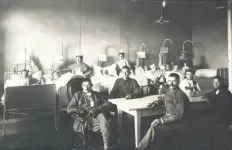(Press-News.org) Exposure to radiation can wreak indiscriminate havoc on cells, tissues, and organs. Curiously, however, some tissues are more vulnerable to radiation damage than others.
Scientists have known these differences involve the protein p53, a well-studied tumor-suppressor protein that initiates a cell's auto-destruct programs. Yet, levels of this sentinel protein are often similar in tissues with vastly different sensitivities to radiation, posing the question: How is p53 involved?
A new study by researchers in the Blavatnik Institute at Harvard Medical School, Massachusetts General Hospital, and the Novartis Institutes for BioMedical Research now sheds light on this mystery.
Reporting in Nature Communications on Feb. 9, they describe how cellular survival after radiation exposure depends on behavior of p53 over time. In vulnerable tissues, p53 levels go up and remain high, leading to cell death. In tissues that tend to survive radiation damage, p53 levels oscillate up and down.
"Dynamics matter. How things change over time matters," said co-corresponding author Galit Lahav, the Novartis Professor of Systems Biology at HMS. "Our ability to understand biology is limited when we only look at snapshots. By seeing how things evolve temporally, we gain much richer information that can be critical for dissecting diseases and creating new therapies."
Notably, the findings suggest new strategies to improve combination therapies for cancer. The team found certain types of tumors in mice were more vulnerable to radiation after being given a drug that blocks p53 levels from declining and oscillating. Tumors treated this way shrunk significantly more than when given either radiation alone or the drug alone.
"We were able to connect differences in temporal p53 expression with radiation response, and these insights allowed us to 'coax' radioresistant tumors into more radiosensitive ones," said co-corresponding author Ralph Weissleder, the Thrall Family Professor of Radiology and HMS professor of systems biology at Mass General. "This is an incredibly exciting study showing that basic science done in rigorous quantitative fashion can lead to new important clinical discoveries."
When cells are exposed to ionizing radiation, high-energy atomic particles haphazardly assault the delicate molecular machinery inside. If this damage cannot be repaired, particularly to DNA, cells will self-destruct to protect the surrounding tissue and organism as a whole.
This act of cellular seppuku is regulated by p53, which acts as a sentinel for genomic damage. The protein is also a famous tumor suppressor--around half of human cancers have p53 mutations that render it defective or suboptimal. Previously, Lahav and colleagues revealed the dynamic behavior of p53 over time and how it affects cancer drug efficacy, cell fate, and more.
Stronger together
In the current study, Lahav, Weissleder, and their team looked at tissues in mice that have very different sensitivities to ionizing radiation yet are known to express comparable levels of p53--the spleen and thymus, which are highly vulnerable, and the large and small intestines, which are more radioresistant.
Under normal conditions, cells express little to no p53. After radiation exposure, all four tissues expressed elevated p53 along with other markers of DNA and cellular damage as expected. But quantitative imaging analyses revealed that p53 in the intestines peaked and then declined a few hours after irradiation. By contrast, p53 in the spleen and thymus remained high over the same time period.
To probe the effects of p53 behavior, the team used an experimental anti-cancer drug to inhibit MDM2, a protein that degrades p53. They found that by blocking MDM2 activity after radiation exposure, p53 could be forced to remain elevated in cells where it would otherwise decline. In the intestine, which is normally more resistant to radiation, the addition of the drug reduced cell viability and survival.
Some cancers can become resistant to radiation therapy. So, the team explored whether manipulating p53 dynamics could increase tumor vulnerability, focusing on human colon cancer cell lines with unmutated, functional p53.
In mice with transplanted human colon cancer tumors, the team observed significant tumor shrinkage after a single dose of MDM2 inhibitor given shortly after irradiation. After around 6 weeks, tumors treated with radiation and the drug together were five-times smaller than those treated with the drug alone and half the size of those treated with only with radiation.
"By irradiating first, we force the cancer cells to activate p53, and by adding MDM2 inhibitor on top of that, we can keep p53 active longer," Lahav said. "This combination has a much stronger effect than either alone."
The findings support the importance of understanding the dynamics of p53 and how to manipulate it to treat cancer.
Combination therapies using MDM2 inhibitors are currently being evaluated in clinical trials, the authors note, but these efforts are not designed to examine the underlying mechanisms and timing of the treatments. Further studies are needed to better understand p53 dynamics in cancer, which can inform how to better combine and time therapies to treat patients with cancer.
In addition, although the researchers identified differences in p53 dynamics in different tissues after radiation exposure, the biological pathways that lead to these differences remains a question for future study.
"For a lab studying p53, cancer is always a major motivation. Our goal is to acquire knowledge to help develop better and more efficient therapies," Lahav said. "Understanding how p53 behaves over time in different conditions is a critical piece of the puzzle."
INFORMATION:
Additional authors on the study include Jacob Ornstein, Yoshiko Iwamoto, Miles Miller, Mark Prytyskach, Stephane Ferretti, Philipp Holzer, Joerg Kallen, Pascal Fure, Ashwini Jambhekar, and William Forrester.
The work was supported in part by the National Institutes of Health (grants GM116864, GM083303, CA207727, CA206997, and CA206890), the Novartis Institutes for BioMedical Research, and the Harvard Ludwig Center for Cancer Research.
What is the best way to monitor a brain tumor? This question is at the heart of a new Position Statement published in open-access journal Frontiers in Oncology. The article is the work of a large collaboration of UK experts and stakeholders who met to discuss the value of routinely imaging brain tumor patients to assess their tumor treatment response, which is known as "interval imaging". Their verdict: there is very limited evidence to support the practice at present. However, the article also discusses how future research could determine and maximize the value of interval ...
A new study in Frontiers in Communication has demonstrated the powerful impact that subtle messaging and cues, or 'nudges', can provide on encouraging people to show socially desirable behaviors. Travelers who were observed on the Indonesian island of Gili Trawangan, a popular tourist destination, were more likely to demonstrate environmentally conscious actions, such as refusing a plastic bag or avoiding contact with a coral reef, when they were 'nudged' towards the desirable action with either a written or face to face interaction. The researchers found that any intervention, whether framed positively or negatively, was ...
Asthma attack rates seen at GP surgeries fell significantly during the first Covid-19 pandemic lockdown of 2020, a study suggests.
Lower levels of air pollution, fewer cold and flu infections, and the fear of attending doctor surgeries due to Covid-19 were possible reasons for the 20pc drop in cases seen at GP surgeries, researchers said.
The study is the first national review of lockdown effects on asthma attacks and includes data from more than 100,000 patients.
Asthma attacks - or exacerbations - are bouts of shortness of breath, wheezing or a tight chest. There are usually more than six million GP consultations and 1400 deaths attributed to asthma in the UK every year.
For the study researchers from the University of Edinburgh looked at a national GP database ...
Higher excess COVID-19 death risk in middle-aged people with type 2 diabetes raises vaccine prioritisation questions
A largescale analysis led by the University of Exeter and funded by Diabetes UK, has found a disproportionately higher COVID-19 death risk in middle-aged people with type 2 diabetes, raising questions over vaccination strategies across Europe.
The study, accepted for publication in Diabetologia, found that compared to people of a similar age without type 2 diabetes, the additional COVID-19 mortality risk from having type 2 diabetes increases the younger someone is. Although the ...
Children aged between 5 months and 4 years attending daycare during lockdown in March to May 2020 in France had low rates of SARS-CoV-2 antibodies in their blood - known as seroprevalence - suggesting that virus infection rates were low in this population.
Research assessing seroprevalence in daycare centres that remained open during the first national lockdown in France, suggests that the rate of SARS-CoV-2 virus infection was low at 3.7%, with positive cases likely infected by an adult in their household, rather than whilst at daycare. The seroprevalence rate among daycare staff was similar to that of a control group of adults who were not exposed to children or COVID positive patients ...
In the event of a pandemic, delayed reactions and a decentralized approach by the authorities at the start of a follow-up wave can lead to longer-lasting, more severe and more fatal consequences, researchers from the universities of Zurich and Toronto have found. The interdisciplinary team compared the Spanish flu of 1918 and 1919 in the Canton of Bern with the coronavirus pandemic of 2020.
The Spanish flu was the greatest demographic catastrophe in Switzerland's recent history, causing approximately 25,000 deaths in the country during 1918 and 1919. In the wake of the current coronavirus pandemic, there has been increased public and scientific interest in the events of that time. An interdisciplinary team of researchers in evolutionary medicine, history, geography and ...
Oakland, Calif. -- An analysis of Kaiser Permanente members in Northern California early in the COVID-19 pandemic found racial and ethnic disparities in the likelihood of testing positive for the coronavirus, but no significant disparities in mortality among those who were hospitalized.
According to the study published Feb. 8 in Annals of Internal Medicine, Latino patients were nearly 4 times as likely as white patients to become infected with the virus, while Asian and Black patients were 2 times as likely to get COVID-19 as white patients. The odds of hospitalization were also higher for Latino, Asian, and Black patients with ...
PITTSBURGH, Feb. 8, 2021 - With the aid of sophisticated machine learning, researchers at UPMC and the University of Pittsburgh School of Medicine demonstrated that a tool they developed can rapidly predict mortality for patients facing transfer between hospitals in order to access higher-acuity care. This research, published today in PLOS One, could help physicians, patients and their families avoid unnecessary hospital transfers and low-value treatments, while better focusing on the goals of care expressed by patients.
Each year, nearly 1.6 million patients--or as much as 3.5% of all inpatient admissions--are transferred from one hospital to another to access specialized care for complex conditions. ...
Economic growth is often prescribed as a sure way of increasing the well-being of people in low-income countries, but a study led by McGill and the Institute of Environmental Sciences and Technologies at the Universitat Autònoma de Barcelona (ICTA-UAB) suggests that there may be good reason to question this assumption. The researchers set out to find out how people rate their subjective well-being in societies where money plays a minimal role, and which are not usually included in global happiness surveys. They found that the majority of people reported remarkably high levels of happiness. This was especially true in the communities with the lowest levels of monetization, where citizens reported a degree of happiness comparable to that ...
ITHACA, N.Y. - Soft robots may not be in touch with human feelings, but they are getting better at feeling human touch.
Cornell University researchers have created a low-cost method for soft, deformable robots to detect a range of physical interactions, from pats to punches to hugs, without relying on touch at all. Instead, a USB camera located inside the robot captures the shadow movements of hand gestures on the robot's skin and classifies them with machine-learning software.
The group's paper, "ShadowSense: Detecting Human Touch in a Social Robot Using Shadow ...



